Learn about the most interesting historical buildings, forts, palaces and monuments in the cruise port of Livorno.
On this page the cruise traveler will find some lesser know but interesting historical landmarks to enjoy on a cruise calling at the port of Livorno.
Landmarks Overview
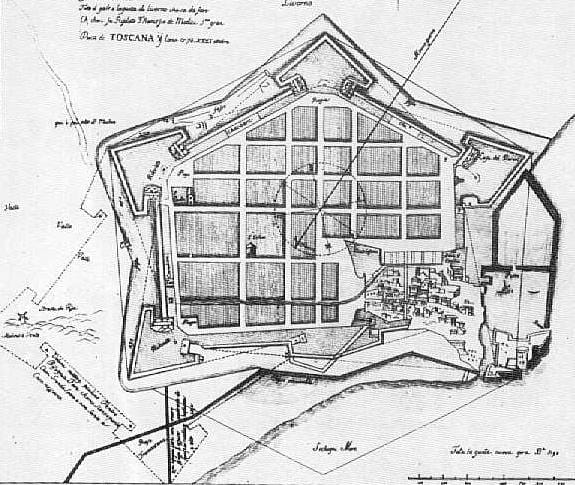
Photo Public Domain
Livorno doesn’t have a Leaning Tower like the famous one in Pisa, nor the architectural and artistic richness of Florence but, even so, it is a very interesting city, considering that it was one of the first towns in the Europe (and the World) that was designed following a master urban plan and built as an "Ideal City". Cruise Travelers staying in port will find a good number of landmarks, which add to the enjoyment of meandering the historical center.
Among the top landmarks, the Old Fort, in particular, is a symbol of Livorno's renaissance. It was designed by the Florentine architect Antonio da Sangallo the Elder (c. 1453 – December 27, 1534) - not to be confused with his nephew and more famous Antonio da Sangallo the Younger.
The New Fort, with its polygonal shape, is impossible to be missed when meandering through the Venice Quarter but it is from Piazza della Repubblica and the large avenue that borders the canal that you will have the best view of the fort and will be able to admire the size of this huge red brick structure.
Three palaces in Piazza Municipio are landmarks of architectural interest: the Palazzo Comunnale (Town Hall), the Palazzo della Dogana (Chamber of Commerce) and the Palazzo Granducale (Grand Ducal Palace).
The two cisterns (the small and the large) and especially the first one at the end of Via Grande are striking structures. Finally, the 19th century Grand Hotel Palazzo on Viale Italia is a great example of romanticism in architecture.
Fortezza Vecchia (Old Fort) - First Defense
The Mastio di Matilde tower of the fort dates back to the 11th century and in the 16th century the Medicis had the fort proper constructed in order to defend the port. Today the fort not only speaks of a time long ago but also draws the city together as a cultural center.
For those who are lucky enough to visit the fort during the day, it offers spectacular views of the harbor and the city. During the fight for the unification of Italy (historically know as the Risorgimento), it became a political prison, with "famous' inmates like Francesco Domenico Guerrazzi, Enrico Bartelloni and Don Maggini.
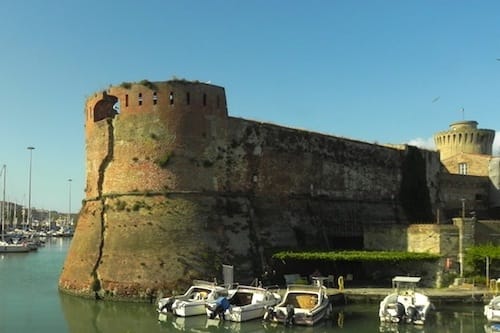
Photo © IQCruising.com
Where: Porto Mediceo
What: Livorno's Oldest Fort
When: Foundations in the 11th Century.
Trivia: When Cosimo Medici began the development of Livorno a palace was built inside this fort in order for him to comfortably supervise the endeavor.
Enjoy: Magnificent views of Port and City - when and if open.
Good to Know: The Boat Tours in the Fosso Reale offers great views of this fort that is very seldom open to the public.
Fortezza Nuova (New Fort), the ultimate defense
Fortezza Nuova means New Fort and it was built at the end of the 16th century following the plan attributed to Don Giovanni dei Medici, Cosimo I’s natural son, with assistance of the architects Vincenzo Buonanni and Bernardo Buontalenti.
The original fort was twice the size of what it is now - part of it was demolished when two new quarters were developed - Venezia and San Marco.
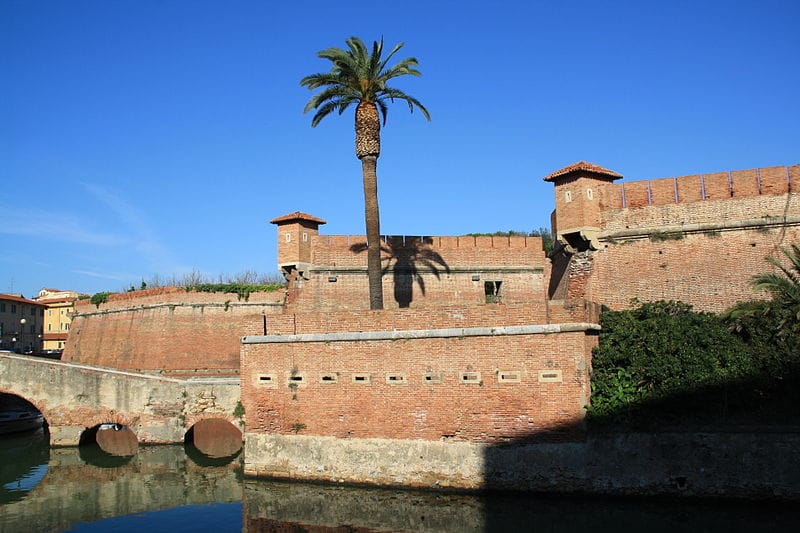
Photo by Piergiuliano Chesi CC by-SA
Polygonal in shape, built with red bricks, and surrounded by the famous Medici canals, this fort is situated in what is known as Venice Quarter. The fort has a history of defending Livorno against attacks from pirates and it is filled with underground passages and vaulted hallways.
The interior of the fort has become home to one of Livorno's most popular and most loved parks although, like the older cousin, only seldom is open to the public.
Where: Venice Quarter
What: Livorno's Northern Defense
When: First stone laid on 10 January 1590
Trivia: Although bombed during the WWII, it was used as a shelter by many who had their homes destroyed.
To visit: the park in the interior - when and if open.
Good to Know: The Boat Tours in the Fosso Reale offer great views of this magnificent fort.
Palazzo Comunale (or Municipali) - Town Hall
Palazzo Comunale (or Municipali as it is many times referred to) is the historic town hall of Livorno and is located in the south corner of Piazza Municipio, where shuttle buses stop.
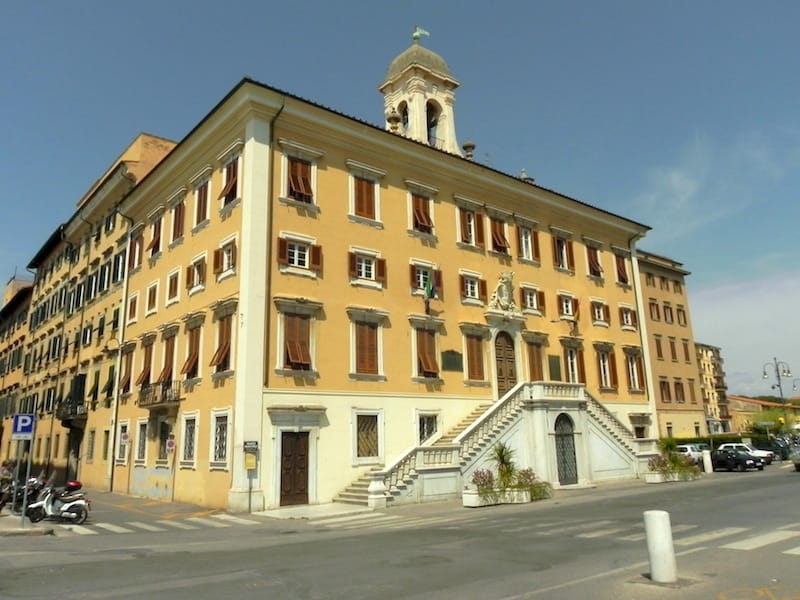
Photo © IQCruising.com
The current building was constructed in 1720 but was so damaged in the earthquake of 1742 that most of it had to be rebuilt. Renovated and embellished in 1929, it was again damaged during World War II and had to be repaired after the war was over.
The neo-renaissance style building boasts a beautiful marble double staircase at its entrance, and a small bell tower.
Where: on Piazza Municipio, in the city centre.
When: buile between 1720 and 1929.
Architect: Legnani and Sabatini.
Trivia: There is with a bronze reproduction of Donatello’s David in the Council Chamber.
Good to Know:Less than 100 meters east, along Via deggli Avvalorati, the St. John of Nepomuk monument stands on a small bridge over Via Madonna.
Palazzo della Dogana (Chamber of Commerce)
Located in Piazza dell Municipio, the Palazzo della Dogana (also referred to as Camera di Comercio) was built in the 17th century to accommodate the Treasury. Later it also became the home of the Chamber of Commerce.
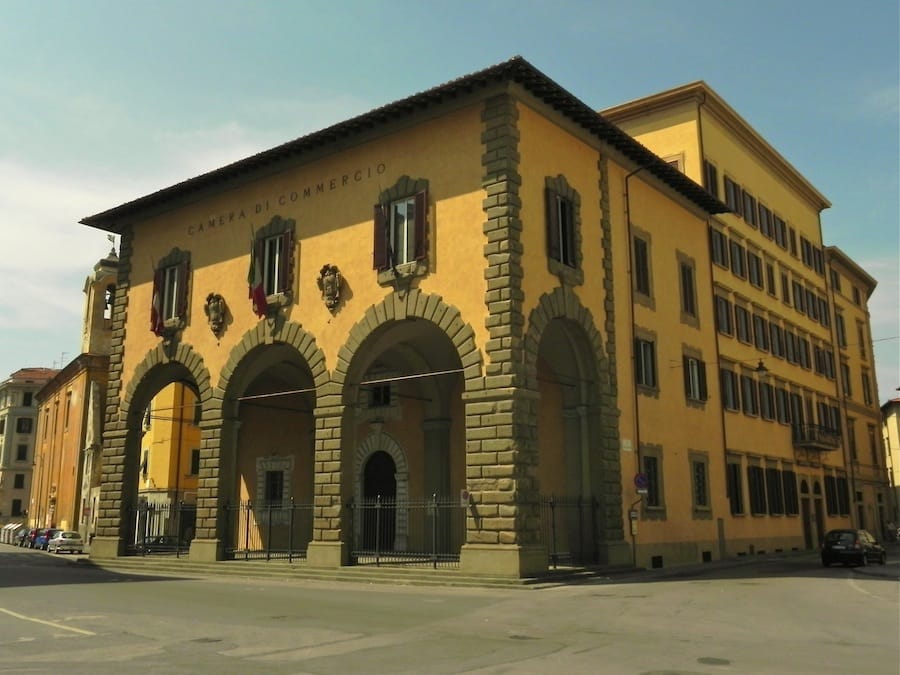
Photo © IQCruising.com
The building had to be repaired after the bombing of World War II and its most remarkable feature is the triple arches on the front, closed by iron gates, that support the upper floor.
The rooms on the main floor have high vaulted ceilings and the ceilings on the second floor are made of wood.
Where: on Piazza Municipio
When: 1648 - Establishment of the Chamber of Commerce in 1801
Architect: Annibale Cecchi of Pistoia
Trivia: The first official draw of lottery in Tuscany was held at the loggia in 1740.
Palazzo Granducale (Grand Ducal Palace)
Commissioned by Ferdinand II to stylishly welcome guests who visited the city it was initially built in 1605 and enlarged in 1629 as a Grand-Ducal residence. It housed the Royal Technical and Nautical Institutes from 1871 until 1929 when it become the house of the Provincial Administration.
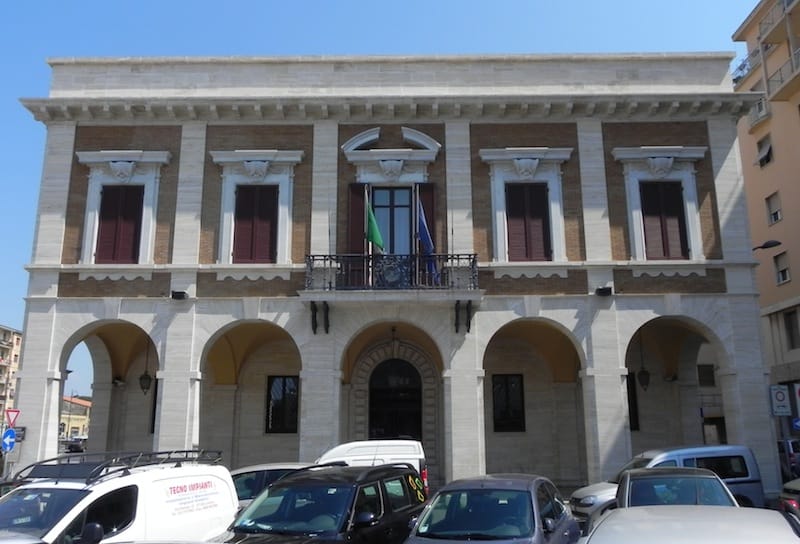
Photo © IQCruising.com
It was completely destroyed during the bombing of World War II. When reconstructed, only part of the palace and the facade were built as per the original design. In fact, what once was the palace become two adjoining buildings - the one facing the Piazza Municipio recreating the style of the old palace.
Where: City Center - Piazza Municipio
When: Final reconstruction inaugurated on 3 August 1948
Architect: Antonio Cantagallina (1605) and Giovanni Battista Santi (1629)
Trivia: Napoleon Bonaparte stayed in the Palace
Good to Know: Via della Madonna, with its three famous churches, is just behind the palace.
Cisternino (The Small Cistern)
The Cisternino was built in 1832 and was designed to hold water and increase the fresh water supply available to the inhabitants of the city.
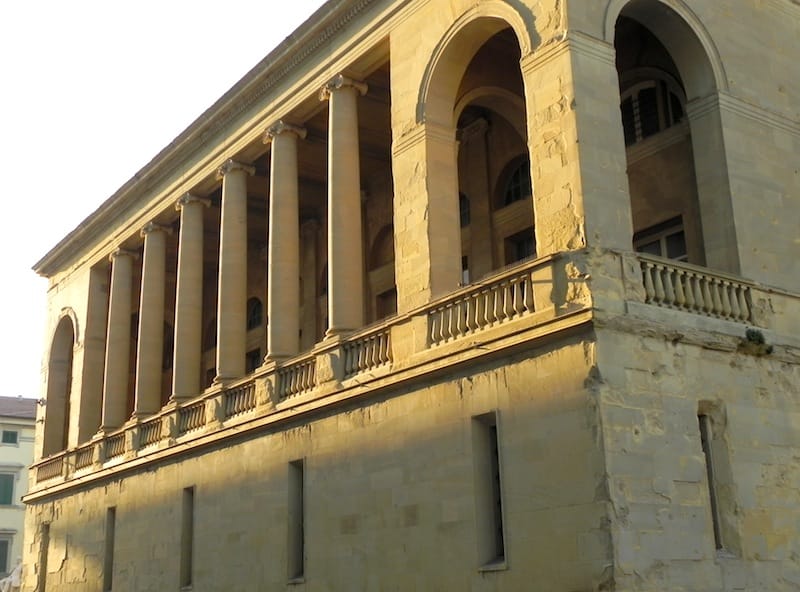
Photo © IQCruising.com
Although the Cisternino was never used for water storage as originally planned, it is still a fascinating building that was built in a classical style. At the north end of Via Grande, is is nestled between Piazza Guerrazzi and Piazza della Repubblica.
Where: in City Centre - east end of Via Grande
When: Commissioned by Grand-Duke Leopoldo II of Lorraine in 1832
Architect: Pasquale Poccianti
What's nearby: Next to Cisternino, in the corner of the Piazza della Repubblica, there is a statue of the painter Giovanni Fattori
Cisternone (Big Cistern)
The Cisternone is a large building that was erected to purify and hold the water that was brought to Livorno along the Colognole Aqueduct.
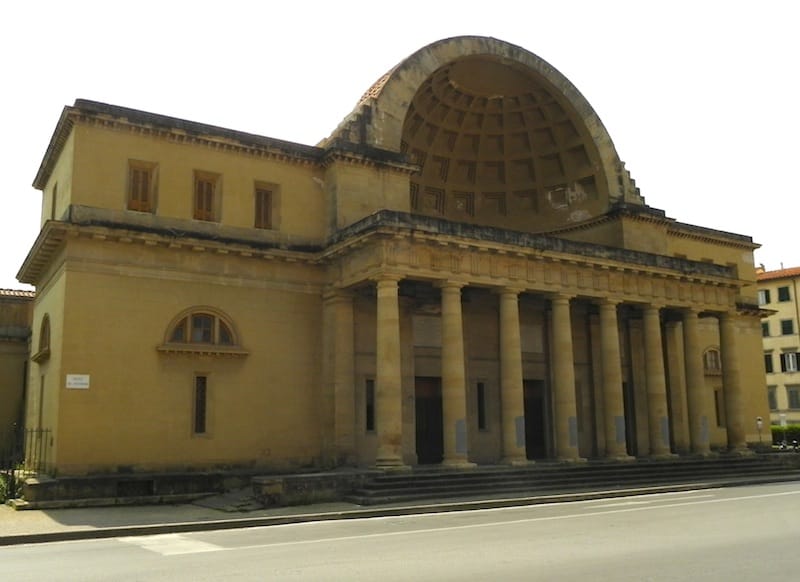
Photo © IQCruising.com
The interior of the building is divided into chambers and the entire building is built in a neoclassical style. The Cisternone was built in the mid-19th century and is still in use today holding over 11,000 cubic meters of water.
Where: OFF the City Centre - East of Piazza della Repubblica at the end of Via Laderel
When: inaugurated in 1842 by the Grand-Duke Leopoldo II of Lorraine.
Architect: Pasquale Poccianti
Trivia: Is 38 meters wide and 42 meters long
Good to Know:it is impossible to miss on the way to Train Station on the right hand side.
Hotel Palazzo (Palazzo Hotel)
This is one of the oldest hotels in Livorno. Built in the 19th century, this hotel sits across from the Terrazza Mascagni.
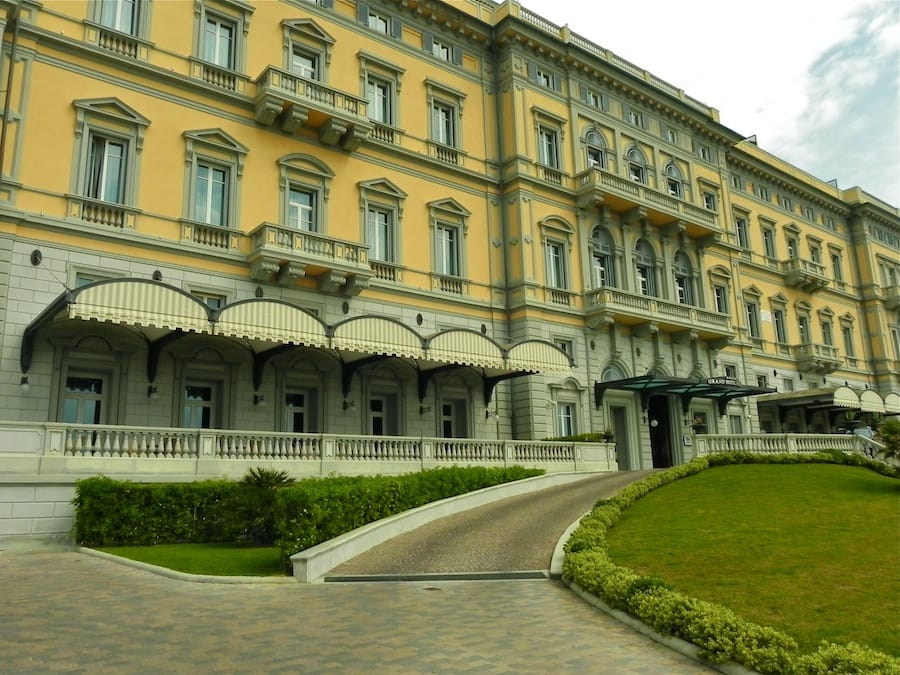
Photo © IQCruising.com
The Palazzo was the hotel of the elite in the 19th century and has recently been reopened to its former glory and earlier splendor as a 5 star hotel.
Where: two miles (3 km) from the City Centre, next to Terrazza Mascagni
When: the restaurant of the Hotel Palazzo is a favorite stop for a gourmet lunch when exploring the south coast of Livorno.
Address: Viale Italia, 195
What's nearby: Terrazza Mascagni, Museo Fattori and the Aquarium
Good to Know: the City Sightseeing Bus stops close by.





